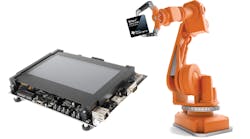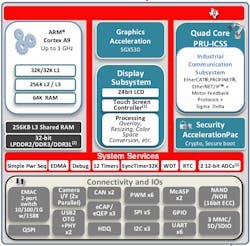SoC Can Handle Multiple Industrial Networks
Texas Instrument's Sitara AM437x (Fig. 1) targets industrial control applications that are networked often using protocols like EtherCAT, Ethernet/IP and PROFINET. The system-on-chip is based on Arm's Cortex-A9 core running at 1 Ghz. It incorporates hardware offload support for features like the display subsystem, motor control and network protocols. It also has a single cycle vector floating point unit.
The AM437x has access to off-chip LPDDR2/DDR3/DDR3L memory as well as 256 Kbytes of shared RAM that can be used as an L3 cache. It also has 32 Kbyte L1 instruction and data caches and a 64 Kbyte scratch memory.
The chip (Fig. 2) also includes four Programmable Real-Time Unit Industrial Communication Subsystems (PRU-ICSS). A PRU-ICSSt can handle network protocols like EtherCAT, EtherNET/IP and PROFINET that can place a burden on a non-accelerated processor. The four controllers have access to the other peripherals including the Gigabit Ethernet interface with a 2-port switch designed to support EtherCAT. EtherCAT slave support is specific to the AM3279 and AM4377. PRU-ICSS units are programmable so they can handle a number of different functions. This includes advanced motor control algorithms.
There are a number of communication interfaces in addition to Ethernet. These include a pair of CAN interfaces, QSPI, SPI, I2C, and UARTs. There are 3 MMC/SD/SDIO interfaces and a 16-bit NAND/NOR flash interface.
The graphics support is based around Imagination Technologies' POWERVR SGX530 3D graphics core. The chip can handle HDMI, a 24-bit LCD screen and it includes touch screen support. There is also support for a pair of standard camera interfaces. The Security AcceleraionPac provides crypto hardware including secure boot support.
The $599 evaluation module (Fig. 3) adds a 7-in WVGA LCD display with touch support. It also has an HDMI output. It has an on-board 2 Mpixel camera and a connector for a second camera. There is one CAN interface and Ethernet port. Third party platforms are available from Calixto Systems, Byte-at-work and Gumstix.
The system is designed to use less than a watt with a deep sleep mode sipping about 5 mW. The real time clock running along consumes under 0.03 mW. There is currently four versions of the 17mm by 17mm chip that are pin compatible. Options include the EtherCAT slave support and graphics support.




